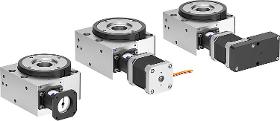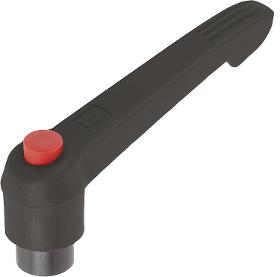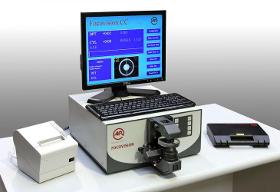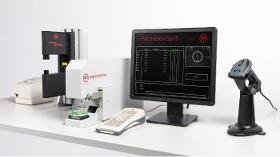- europages
- >
- COMPANIES - SUPPLIERS - SERVICE PROVIDERS
- >
- reference point
Results for
Reference point - Import export

NORELEM FRANCE
France
Base and rotary table aluminium alloy. Hollow shaft stainless steel. Preloaded worm gear steel. Claw coupling aluminium with polyurethane coupling spider. Version Aluminium alloy anodised. Note for ordering The unit is supplied with the position of cable outlet or control unit as shown in the drawing. Note Rotary positioning stages for motorised adjustment and positioning tasks. The preloaded worm gear runs virtually playfree. The bearing of the worm shaft offers maximum radial rotational accuracy. Cables can be routed through the large bore in the hollow shaft. The adjustable positioning ring is used to determine the rotational reference point to the position of the assembled part. Proximity switches can be mounted with the optionally available sensor holder (21094). The suitable programming software and interface cable for the stepper motor with positioning control are available as accessories (2500015).
Request for a quote
NORELEM FRANCE
France
Enter the desired lever colour here. The standard colours are: Black grey clamping lever, traffic red push button. Orange clamping lever, black grey push button. Traffic red clamping lever, black grey push button. Where L ≥ 60 mm the thread length is 60 mm. On request: Other threads, screw lengths and special versions. Dimension “H1” available in other lengths at extra charge. Drawing reference: 1) flat point DIN 78
Request for a quote
AUTOMATION & ROBOTICS (A&R)
Belgium
The Dual LensMapper, integrated in this unit, gives a mapping of the prescription lens (freeform or conventional) and calculates FOA optical power at the reference points (FV, NV). For the freeforms, it compares the expected design to the real lens and displays an error map. A Go/NoGo decision is made, based on the error map and the list of criteria defined by the lab. Because the A&R AutoMapper is task specific, and the system has a small footprint, you can easily integrate it into the lab, either directly after the surfacing or in the final control (also suitable for checking the cut lenses). The AutoMapper is an excellent investment for a modern lab with a rapid payback! 100 % production control just after surfacing --> direct feedback on production* control of the cut lens - in case of remote edging Non contact measurement Correction of eventual R/L inversion Integrated Dual LensMapper : measurement of free form and conventional progressive lenses Control of power, cyl.
Request for a quote
AUTOMATION & ROBOTICS (A&R)
Belgium
The Focovision by Reflection SR-2 is used in the production of semifinished lenses, glass and metal molds,but also in prescription laboratories to control the incoming semi-finished lenses. It measures the surface optical power by reflection on one point with a high degree of accuracy. The measured value can be expressed in curvature or in diopter. The Focovision by Reflection has become a worldwide reference instrument throughout the ophthalmic industry. High accuracy (0.01D for the base power, less than 0.01D for the residual astigmatism of the instrument) Very high reproducibility Precise and reproducible positioning of the lens according to reference points marked over the lens surface Simple and rapid autocalibration procedure No moving parts (behaviour stability, simple lighting system, ...) Linear instrument response (no mechanical adjustments are necessary) Reliability : Image quality control & automatic correction of dust effect
Request for a quote
AUTOMATION & ROBOTICS (A&R)
Belgium
The Focovision by Transmission SPV-3 is used in prescription laboratories. It is connected to your computer network, from which it receives the nominal values of the prescription lens. Its main advantages are repeatability, accuracy, easy calibration, and especially its visualization system of the semivisible marks or the upper segment line corner of the addition. This system permits an accurate positioning on the different control points without any lens marking. It measures the lens optical power by using a light beam perpendicular to the concave lens surface at a certain wavelength (546 nm or 587 nm) and by measuring in all directions (360 degrees). In addition, it has a user friendly interface permitting an operator to learn how to perform the complete lens control (far view, prism reference point, near view, thickness, shape, etc.) with little training required. Minimal training required Very high measurement speed Flexibility (configurable procedures, easy to adapt, any toleran
Request for a quote
HB PUBLICATIONS AND TRAINING INTERNATIONAL
United Kingdom
This is one of a series of books called "Essential skills for the public sector". It includes how to establish the cost of a service; overhead allocation methods: unit cost calculations; cost control; and pricing. It is ideal reading for public sector managers or those studying for public administration and related qualifications. It tackles some of the common costing and pricing issues in the public sector. It is a practical book and has found to be useful in both measuring value for money and financial control. It incorporates worked examples and solutions. This publication is a valuable reference point to anyone having to undergo costing and pricing exercises for their area of service, especially if those services are being exposed to outside competition or performance indicators. A highly recommended publication.
Request for a quoteDo you sell or make similar products?
Sign up to europages and have your products listed
Results for
Reference point - Import exportNumber of results
6 ProductsCountries
Company type